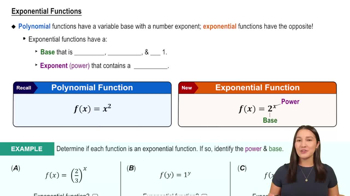Determine the intervals for which the function is concave up or concave down. State the inflection points.
Table of contents
- 0. Functions7h 54m
- Introduction to Functions16m
- Piecewise Functions10m
- Properties of Functions9m
- Common Functions1h 8m
- Transformations5m
- Combining Functions27m
- Exponent rules32m
- Exponential Functions28m
- Logarithmic Functions24m
- Properties of Logarithms36m
- Exponential & Logarithmic Equations35m
- Introduction to Trigonometric Functions38m
- Graphs of Trigonometric Functions44m
- Trigonometric Identities47m
- Inverse Trigonometric Functions48m
- 1. Limits and Continuity2h 2m
- 2. Intro to Derivatives1h 33m
- 3. Techniques of Differentiation3h 18m
- 4. Applications of Derivatives2h 38m
- 5. Graphical Applications of Derivatives6h 2m
- 6. Derivatives of Inverse, Exponential, & Logarithmic Functions2h 37m
- 7. Antiderivatives & Indefinite Integrals1h 26m
- 8. Definite Integrals4h 44m
- 9. Graphical Applications of Integrals2h 27m
- 10. Physics Applications of Integrals 3h 16m
- 11. Integrals of Inverse, Exponential, & Logarithmic Functions2h 31m
- 12. Techniques of Integration7h 41m
- 13. Intro to Differential Equations2h 55m
- 14. Sequences & Series5h 36m
- 15. Power Series2h 19m
- 16. Parametric Equations & Polar Coordinates7h 58m
6. Derivatives of Inverse, Exponential, & Logarithmic Functions
Derivatives of Exponential & Logarithmic Functions
Problem 3.9.48
Textbook Question
15–48. Derivatives Find the derivative of the following functions.
s(t) = cos 2^t
 Verified step by step guidance
Verified step by step guidance1
Identify the function s(t) = cos(2^t). This is a composition of functions, where the outer function is cos(u) and the inner function is u = 2^t.
Apply the chain rule for differentiation, which states that the derivative of a composite function f(g(x)) is f'(g(x)) * g'(x).
Differentiate the outer function with respect to its argument: the derivative of cos(u) is -sin(u).
Differentiate the inner function u = 2^t with respect to t. This requires using the exponential rule: the derivative of a^x is a^x * ln(a). Therefore, the derivative of 2^t is 2^t * ln(2).
Combine the results using the chain rule: the derivative of s(t) is -sin(2^t) * (2^t * ln(2)).
 Verified video answer for a similar problem:
Verified video answer for a similar problem:This video solution was recommended by our tutors as helpful for the problem above
Video duration:
2mPlay a video:
Was this helpful?
Key Concepts
Here are the essential concepts you must grasp in order to answer the question correctly.
Derivatives
A derivative represents the rate of change of a function with respect to its variable. It is a fundamental concept in calculus that allows us to determine how a function behaves at any given point. The derivative is often denoted as f'(x) or dy/dx, and it can be interpreted as the slope of the tangent line to the curve of the function at a specific point.
Recommended video:

Derivatives
Chain Rule
The chain rule is a formula for computing the derivative of a composite function. If a function y = f(g(x)) is composed of two functions, the chain rule states that the derivative is found by multiplying the derivative of the outer function f with the derivative of the inner function g. This rule is essential when differentiating functions that involve other functions, such as exponential or trigonometric functions.
Recommended video:

Intro to the Chain Rule
Exponential Functions
Exponential functions are mathematical functions of the form f(x) = a^x, where 'a' is a constant and 'x' is the variable. In the context of derivatives, the derivative of an exponential function can be computed using the natural logarithm and the chain rule. Understanding how to differentiate exponential functions is crucial for solving problems involving growth and decay, as well as in various applications across science and engineering.
Recommended video:

Exponential Functions

 4:50m
4:50mWatch next
Master Derivatives of General Exponential Functions with a bite sized video explanation from Patrick
Start learningRelated Videos
Related Practice
Multiple Choice
